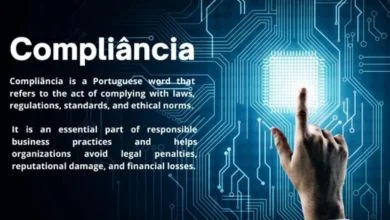What is Compliância? Challenges, Future

What is Compliância?
Compliância is a Portuguese word that refers to the act of complying with laws, regulations, standards, and ethical norms. It is an essential part of responsible business practices and helps organizations avoid legal penalties, reputational damage, and financial losses.
Read More: Where to Find Limited Edition Fear of God Essentials Hoodies
The Evolution of Compliance: A Historical Perspective
Compliance, the act of adhering to rules, regulations, and standards, has undergone a significant evolution throughout history. This evolution can be traced across different eras, each marked by distinct characteristics and challenges.
1. Early Civilizations (3000 BCE – 476 CE):
- Compliance based on tradition and religious law: Early societies relied heavily on customs, traditions, and religious doctrines to dictate behavior. Compliance was ensured through social pressure, religious authority, and sometimes, harsh punishments.
- The limited scope of compliance: Compliance primarily focused on maintaining social order, upholding religious beliefs, and ensuring obedience to rulers.
- Minimal regulatory structures: No formal regulatory bodies or written laws existed in most early civilizations.
2. Medieval Europe (476 CE – 1485 CE):
- Emergence of legal frameworks: The development of feudalism and nation-states led to the establishment of legal systems and formal laws. Compliance became more defined and enforced through legal mechanisms.
- Shifting focus towards governance and commerce: Compliance expanded to encompass governance, economic activities, and trade regulations.
- Rise of guilds and professional associations: These organizations enforced their own standards and codes of conduct, promoting compliance among their members.
3. Industrial Revolution and Modernization (1760 – 1914):
- Increased government intervention: With rapid industrialization, governments intervened to regulate working conditions, safety standards, and environmental protection. This led to a significant expansion of compliance requirements.
- Rise of specialized regulatory bodies: New agencies were established to oversee specific industries and sectors, enforcing compliance through inspections, audits, and penalties.
- Focus on safety and labor standards: Compliance increasingly focused on protecting workers’ rights, ensuring safe working environments, and preventing pollution.
4. Globalization and Technological Advancement (1945 – Present):
- Expansion of international trade and regulatory frameworks: Globalization led to the development of international standards and regulatory bodies, requiring businesses to comply with diverse legal frameworks across different jurisdictions.
- The emergence of new compliance areas: Compliance requirements expanded to encompass areas like data privacy, cybersecurity, intellectual property, and anti-money laundering.
- Technological advancements: The rise of digital technologies has transformed compliance processes, allowing for automation, data-driven compliance management, and real-time monitoring.
Key Elements of an Effective Compliance Program
An effective compliance program is a crucial component of any organization’s risk management strategy. It helps organizations identify, prevent, and mitigate legal and regulatory risks, and fosters a culture of ethics and integrity. A well-designed compliance program can also improve efficiency, reduce costs, and enhance the organization’s reputation.
Here are some key elements of an effective compliance program:
1. Management Commitment and Oversight:
- Senior management must demonstrate strong commitment to compliance by providing resources, setting the tone, and holding employees accountable.
- A dedicated compliance officer or team should be responsible for overseeing the program and ensuring its effectiveness.
2. Risk Assessment:
- Regularly conduct risk assessments to identify and prioritize legal and regulatory risks faced by the organization.
- This helps tailor the compliance program to address the most significant risks.
3. Policies and Procedures:
- Develop clear and concise policies and procedures that outline the organization’s expectations for ethical and compliant behavior.
- These policies should be easily accessible and communicated to all employees.
4. Training and Education:
- Provide regular training and education to employees on relevant laws, regulations, policies, and procedures.
- This helps employees understand their compliance obligations and make informed decisions.
5. Monitoring and Auditing:
- Implement mechanisms to monitor and audit compliance with policies and procedures.
- This helps identify and address any gaps or weaknesses in the program.
6. Reporting and Corrective Action:
- Establish a process for employees to report suspected or actual violations of the compliance program.
- Investigate all reported violations promptly and take appropriate disciplinary action.
7. Continuous Improvement:
- Regularly review and update the compliance program to ensure it remains effective.
- This includes incorporating lessons learned from incidents and changes in the legal and regulatory environment.
Challenges in Compliância
Compliância is a broad term that refers to the act of adhering to rules, regulations, and standards. It is an essential part of doing business, as it helps to protect organizations from legal and financial risks. However, there are several challenges that organizations face in achieving and maintaining compliância.
One of the biggest challenges is the complexity of the regulatory landscape. There are a vast number of laws and regulations that organizations have to comply with, and these regulations are constantly changing. This makes it difficult for organizations to keep up with the latest requirements.
Another challenge is the cost of compliância. Organizations need to invest in resources such as compliance software, training programs, and personnel to ensure that they are compliant. This can be a significant financial burden, especially for small businesses.
In addition, organizations may face cultural challenges to compliância. If there is a strong culture of non-compliance within an organization, it can be difficult to change that culture. This may require a long-term commitment from leadership to change the way employees think about compliância.
Future Trends in Compliance
Compliance refers to the adherence to a set of rules, regulations, or standards. In the rapidly evolving world of today, the landscape of compliance is constantly changing, driven by factors such as technological advancements, globalization, and increased regulatory scrutiny. Here are some key future trends in compliance:
1. Increased Automation and AI: Repetitive and time-consuming compliance tasks will be increasingly automated, freeing up human resources for more strategic activities. Artificial intelligence (AI) will play a key role in this automation, with AI-powered tools being used to analyze data, identify risks, and generate reports.
2. Real-time Compliance: The traditional approach to compliance has been reactive, with organizations focusing on responding to incidents and investigations. However, the future of compliance is moving towards a more proactive and real-time approach. This will involve using technology to continuously monitor compliance risks and take corrective actions in real-time.
3. Integration with Business Processes: Compliance will become more integrated with core business processes. This will involve embedding compliance requirements into existing systems and workflows, making compliance a seamless part of the day-to-day operations.
4. Data-driven Compliance: Organizations will increasingly rely on data to drive their compliance efforts. This will involve using data analytics to identify trends, predict risks, and measure the effectiveness of compliance programs.
5. Global Compliance: As businesses operate in an increasingly globalized world, they will need to comply with a complex and ever-changing web of regulations. This will require organizations to develop sophisticated compliance programs that can manage risks across multiple jurisdictions.
6. Risk-based Compliance: Organizations will move from a compliance-driven approach to a risk-based approach. This means that compliance efforts will be focused on the risks that are most likely to occur and have the greatest impact on the organization.
7. Third-party Compliance: Organizations will increasingly be held responsible for the compliance of their third-party vendors. This means that organizations will need to develop strong third-party risk management programs to ensure that their vendors are compliant with relevant regulations.
8. Focus on Cybersecurity: As cyber threats become more sophisticated, organizations will need to focus on cybersecurity compliance to protect their data and systems. This will involve implementing robust security controls and conducting regular risk assessments.
9. Regulatory Changes: Regulatory bodies will continue to issue new regulations and update existing ones. This means that organizations will need to stay up-to-date on the latest changes and adapt their compliance programs accordingly.
10. Regulatory Technology (RegTech): RegTech is a rapidly growing sector that provides technology solutions for compliance. RegTech solutions can help organizations automate compliance tasks, manage risk, and comply with regulations more effectively.
Conclusion
Compliance is a critical aspect of operating in today’s complex and ever-changing regulatory environment. By staying up-to-date with the latest trends and adapting their compliance programs accordingly, organizations can ensure that they are meeting their obligations and protecting themselves from risks.
The future of compliance is bright, with a focus on automation, real-time monitoring, and data-driven decision-making. By leveraging technology and taking a proactive approach to compliance, organizations can achieve greater efficiency, effectiveness, and resilience.



